You are using an out of date browser. It may not display this or other websites correctly.
You should upgrade or use an alternative browser.
You should upgrade or use an alternative browser.
What makes a diamond ideal/ super ideal?
- Thread starter blingblingdiamond
- Start date
- Joined
- Aug 4, 2008
- Messages
- 15,734
Pavilion angle is what is different in the last 2 I posted.Thanks Karl, your diamond anatomy lessons are very helpful. What were the cut differences in stone 1 and 2 in the examples above?
40.75 vs 41.4
- Joined
- Aug 4, 2008
- Messages
- 15,734
The ideal scope is based on a reflector with 2 color zones + back lighting.
Obstruction is black and light return is red.
Leakage is white, some leakage is normal and provides contrast.
More info here:
https://ideal-scope.com/how-to-use-ideal-scope-products/
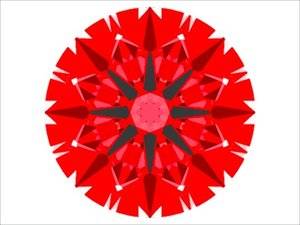
Obstruction is black and light return is red.
Leakage is white, some leakage is normal and provides contrast.
More info here:
https://ideal-scope.com/how-to-use-ideal-scope-products/

- Joined
- Aug 4, 2008
- Messages
- 15,734
The ASET scope developed by AGS and is based on a reflector scope with 3 color zones + a black or white background under the diamond.
The basis of the ASET is from which direction different areas of the diamond are most strongly drawing light.
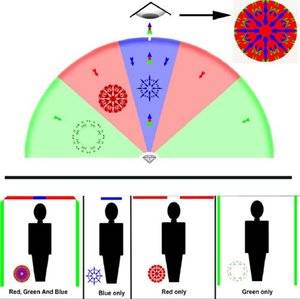
More info and purchase info: https://ideal-scope.com/
The basis of the ASET is from which direction different areas of the diamond are most strongly drawing light.

More info and purchase info: https://ideal-scope.com/
- Joined
- Aug 4, 2008
- Messages
- 15,734
I should have linked this early to help show which facets I was talking about:
https://www.pricescope.com/wiki/diamonds/anatomy-of-round-brilliant-diamond
https://www.pricescope.com/wiki/diamonds/anatomy-of-round-brilliant-diamond
- Joined
- Aug 4, 2008
- Messages
- 15,734
So basically for ideal cut we have: complimentary angles and % that all work together, passes Ideal scope and ASET scope tests. If a diamond passes ASET it will pass the simpler IS.
There are combos that pass these tests that are more suitable for an ear ring or pendant than a ring.
Some will kick a combo out of ideal if its not suitable for a ring.
There are combos that pass these tests that are more suitable for an ear ring or pendant than a ring.
Some will kick a combo out of ideal if its not suitable for a ring.
- Joined
- Aug 4, 2008
- Messages
- 15,734
- Joined
- Aug 4, 2008
- Messages
- 15,734
Now lets move on to super-ideal
On top of being ideal now we move into optical alignment and optical symmetry.
What is optical alignment?
Sticking to the mirror analogy.
You’re standing in front of your mirror doing your hair.
You want to see what the hair on the back of your head looks like.
You grab a hand mirror and hold it up so that it reflects an image of the back of your head into the mirror in front of you.
Then you move the small mirror around until your head, the small mirror, the big mirror in front of you, and your eyes are in alignment so you can clearly see the back of your head.
This is optical alignment. The mirrors are in optical alignment with each other, and relative to the back of your head and your eyes.
You just created an optically aligned system.
What is optical symmetry? It is when multiple reflectors are optically aligned with each other.
On top of being ideal now we move into optical alignment and optical symmetry.
What is optical alignment?
Sticking to the mirror analogy.
You’re standing in front of your mirror doing your hair.
You want to see what the hair on the back of your head looks like.
You grab a hand mirror and hold it up so that it reflects an image of the back of your head into the mirror in front of you.
Then you move the small mirror around until your head, the small mirror, the big mirror in front of you, and your eyes are in alignment so you can clearly see the back of your head.
This is optical alignment. The mirrors are in optical alignment with each other, and relative to the back of your head and your eyes.
You just created an optically aligned system.
What is optical symmetry? It is when multiple reflectors are optically aligned with each other.
In a diamond we see reflections instead reflectors. Reflections do not depend from reflectors alignment only. it is strongly depends from viewing direction. if you turn diamond or viewing direction then you see other reflections, other VF's.
By human eyes you do not see same VF's that you see in a mono image under IS, ASET, H&A lights.
There are not any proof that Super Ideal optical symmetry increases Optical Performance in compare with just Good Optical symmetry.
Yes , it is easy to proof that Good Optical symmetry increases Optical performance in compare with Bad Optical symmetry. But any theoretical Interpolation here is not scientific approach, it is a marketing.
Of course mono Super Ideal Optical symmetry has value as proof of high level craftsmanship , BUT
some cutters reduce facet flatness in attempt to achieve Highest Level Optical and 3D symmetry( for example zero junctions) . Bad facet flatness reduces Optical performance . So a diamond with highest Optical symmetry would have worse Optical performance than diamond with worse/less Optical performance and same proportions
By human eyes you do not see same VF's that you see in a mono image under IS, ASET, H&A lights.
There are not any proof that Super Ideal optical symmetry increases Optical Performance in compare with just Good Optical symmetry.
Yes , it is easy to proof that Good Optical symmetry increases Optical performance in compare with Bad Optical symmetry. But any theoretical Interpolation here is not scientific approach, it is a marketing.
Of course mono Super Ideal Optical symmetry has value as proof of high level craftsmanship , BUT
some cutters reduce facet flatness in attempt to achieve Highest Level Optical and 3D symmetry( for example zero junctions) . Bad facet flatness reduces Optical performance . So a diamond with highest Optical symmetry would have worse Optical performance than diamond with worse/less Optical performance and same proportions
- Joined
- Aug 4, 2008
- Messages
- 15,734
Yes Serg,
At some distances and lighting we see the play of light across the virtual facets, at longer distances and lighting dependent we see the light show produced by the virtual facets but not the virtual facets themselves.
We see a two eyed view interpretation of the diamond/light show not mono like a picture or scope view.
Virtual facets are also relative to the viewer and 3 people standing side by side looking at a diamond are all 3 looking at or seeing the effects of 3 different sets of virtual facets and 3 different lighting environments.
I am not yet ready to go into my opinions on optical symmetry but I will certainly keep your opinion in mind.
My thoughts are not that far from yours, maybe just a matter of degree.
I do agree that solid scientific evidence is lacking.
Some of the "tricks" that cutters can use is really beyond the scope of what I was going to discuss but it is very interesting.
At some distances and lighting we see the play of light across the virtual facets, at longer distances and lighting dependent we see the light show produced by the virtual facets but not the virtual facets themselves.
We see a two eyed view interpretation of the diamond/light show not mono like a picture or scope view.
Virtual facets are also relative to the viewer and 3 people standing side by side looking at a diamond are all 3 looking at or seeing the effects of 3 different sets of virtual facets and 3 different lighting environments.
I am not yet ready to go into my opinions on optical symmetry but I will certainly keep your opinion in mind.
My thoughts are not that far from yours, maybe just a matter of degree.
I do agree that solid scientific evidence is lacking.
Some of the "tricks" that cutters can use is really beyond the scope of what I was going to discuss but it is very interesting.
- Joined
- Aug 4, 2008
- Messages
- 15,734
up next is H&A
I just so happens that when a modern round brilliant is optically symmetrical a pattern of hearts and arrows can be observed if the proportions are in a certain range. It just happens that that range somewhat overlaps one of the better ranges of facet angles and % to be ideal or well cut.
A scope was developed to view them better and marketing machines geared up!
At that time is was a large undertaking to cut them and specialized lines, process and tools were needed.
That is still somewhat true today at the top end but with better tools and process is not always the case.
H&A are not the only possible symmetry patterns for example clefty hearts are not considered h&a but they are optically symmetrical.
Optical symmetry does not guarantee good performance the rest of the details must be correct to get top performance.
Arrows:
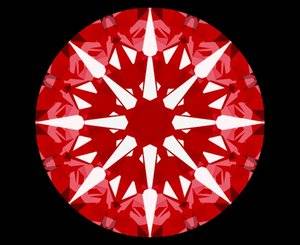
Hearts:
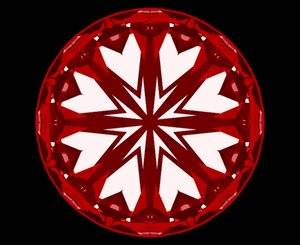
clefty hearts
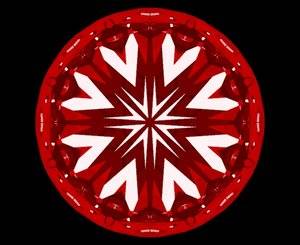
I just so happens that when a modern round brilliant is optically symmetrical a pattern of hearts and arrows can be observed if the proportions are in a certain range. It just happens that that range somewhat overlaps one of the better ranges of facet angles and % to be ideal or well cut.
A scope was developed to view them better and marketing machines geared up!
At that time is was a large undertaking to cut them and specialized lines, process and tools were needed.
That is still somewhat true today at the top end but with better tools and process is not always the case.
H&A are not the only possible symmetry patterns for example clefty hearts are not considered h&a but they are optically symmetrical.
Optical symmetry does not guarantee good performance the rest of the details must be correct to get top performance.
Arrows:

Hearts:

clefty hearts

- Joined
- Jul 27, 2009
- Messages
- 4,097
Based upon your statement above, which I agree with, maybe you should amend your saying to:Why are virtual facets important?
Every aspect of diamond performance other than facet glare begins and ends with virtual facets. Each virtual facet draws light from and returns light to a different parts of the environment around it.(they can also draw light from multiple locations and return it to multiple locations) Basically virtual facets it what separates a polished diamond from a mirror.
If you want to stop there and keep it simple,
Precision cutting creates more precise and uniform virtual facets and optical alignment increases their efficiency at returning visible light.
I'm going to catch some flak on that statement because it is grossly over simplified.
Remember what I said about disagreement earlier?
That's all for tonight.
Edit: The most important aspect of diamond performance is always lighting and how clean it is at that moment.
Maybe I should change my saying that the 5 most important things for diamond performance are: cleanliness, lighting,lighting, lighting, lighting.
cut precision, cleanliness, lighting, lighting, lighting.
- Joined
- Aug 4, 2008
- Messages
- 15,734
nope lighting is above all, all diamonds look the same in the dark :}Based upon your statement above, which I agree with, maybe you should amend your saying to:
cut precision, cleanliness, lighting, lighting, lighting.
Some lighting can make frozen spit look awesome and is not conductive to cut comparisons.
Which is why viewing a diamond in multiple lighting environments, preferably your own is recommended.
I will be back soon to add to this thread. Have other stuff going on right now.
- Joined
- Apr 7, 2005
- Messages
- 293
If Karl will indulge me, I'd like to add a quick and dirty analogy.
Image a mirror. The light return is strong, but there's only one facet and no sparkle
Now play the child's trick with two facing mirrors. Suddenly two mirrors are an infinite number of mirrors. But the mirrors get increasingly dim as they move "back."
Now imagine a third mirror, and you get even more dim reflections.
Now put in 57 mirrors. That's so many that you'd have to spend a couple of hours just arranging the mirrors to all face each other.
Now the final step is to tweak the 57 mirrors until some of the additional reflections perfectly overlap one another.There's way fewer virtual mirrors now, but those that remain are all brighter. What's more, if you tilt and move the mirrors, you get a cool 3D effect where the virtual images shift and rotate in space.
Now imagine how much work it takes to arrange those 57 mirrors like that, and you'll get some insight into what it takes to bring us these stones. And then change the relative sizes of the mirrors and cut me an AVR.
Mindblown by @ChristineRose (insert purple cloud burst)
- Joined
- Aug 4, 2008
- Messages
- 15,734
narrow arrows and a more splintery appearance. Brightness would be about the same, fire could increase in some lighting, decrease in others compared to same size stones with same table/crown/pavilion angles.So @Karl_K how does having clefty hearts affect a diamond face up? Sorry if this is a stupid question but would it affect the arrows pattern? What about brightness and fire? Thank you, I enjoy your explanations
It isn't as universal across a wide range of lighting as shorter lowers in the same angles range as ideal cuts.
However it is an advantage in stones that have borderline contrast issues.(shallow pavilions)
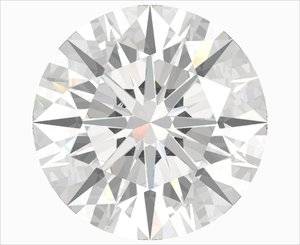
Share:
The Ultimate Guide to Men’s Wedding Bands: Metals, Fit & Finish
The Ultimate Guide to Men’s Wedding Bands: Metals, Fit & Finish - 06/27
Chipped Diamonds: Causes, Risks, and What You Should Do About It
Chipped Diamonds: Causes, Risks, and What You Should Do About It - 06/27



300x240.png)